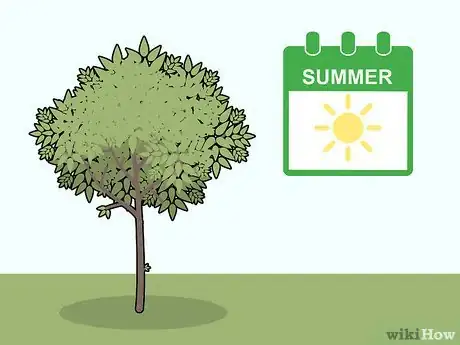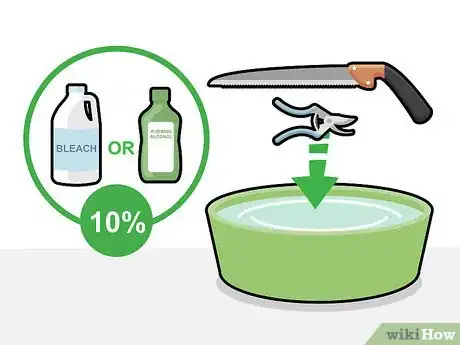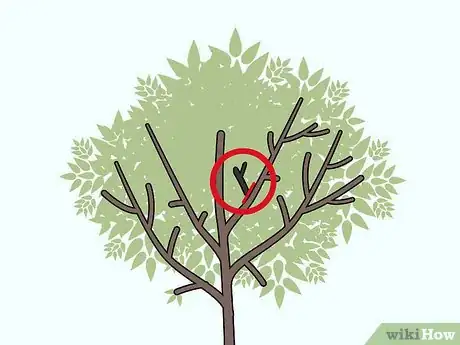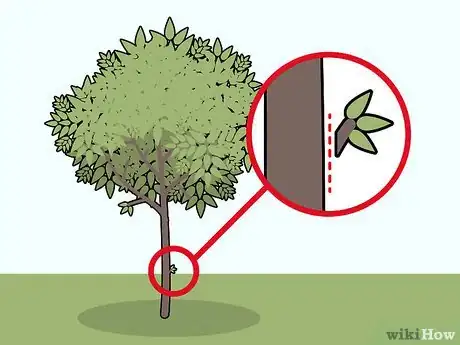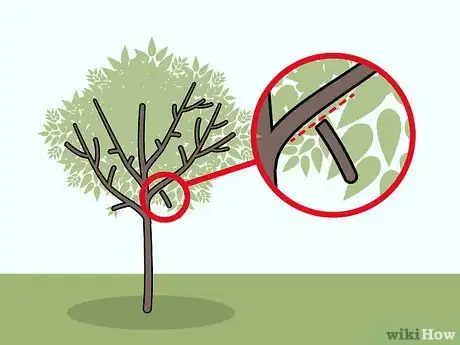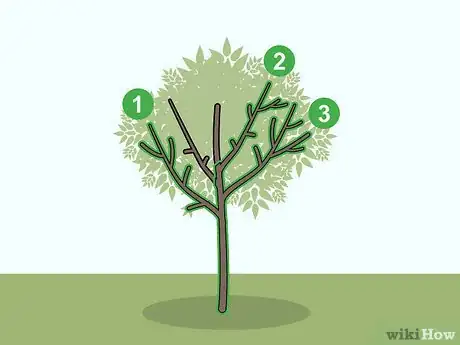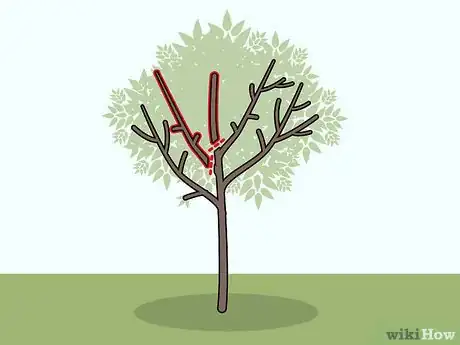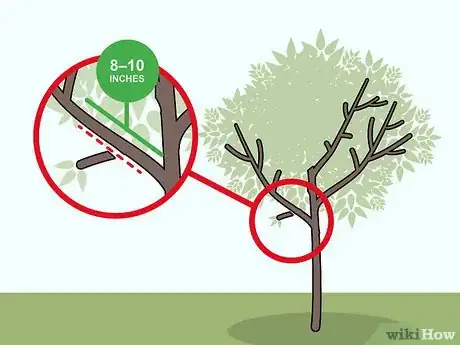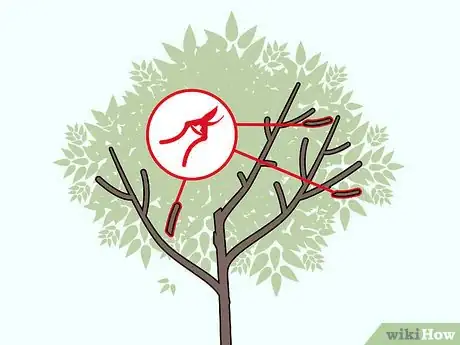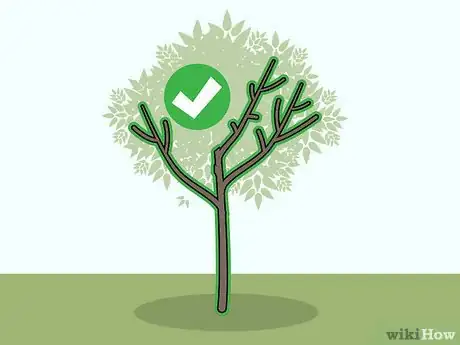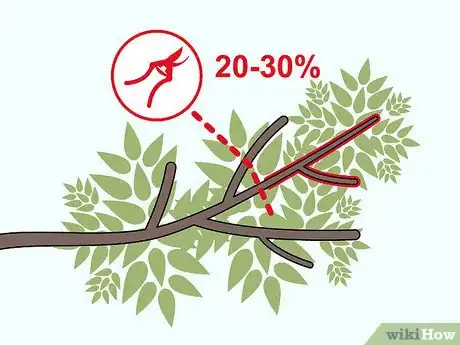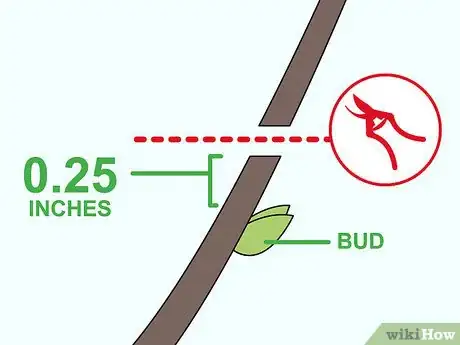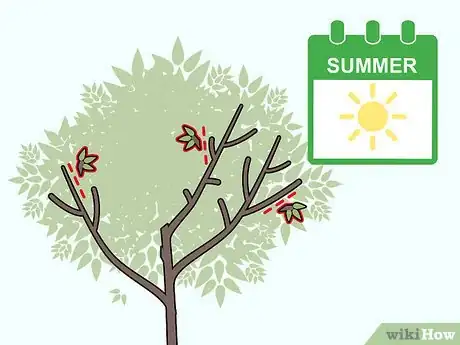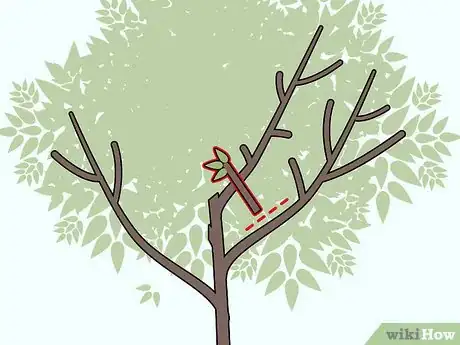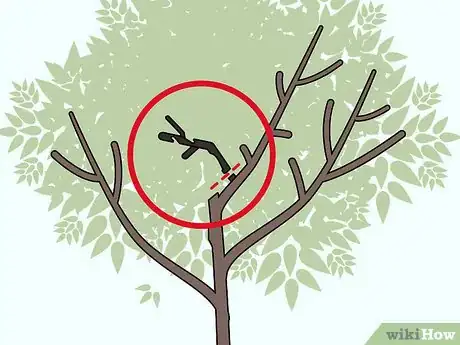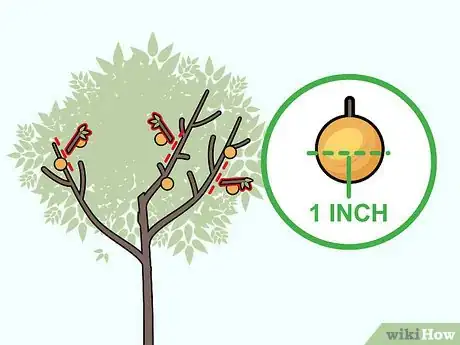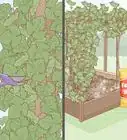This article was co-authored by Steve Masley. Steve Masley has been designing and maintaining organic vegetable gardens in the San Francisco Bay Area for over 30 years. He is an Organic Gardening Consultant and Founder of Grow-It-Organically, a website that teaches clients and students the ins and outs of organic vegetable gardening. In 2007 and 2008, Steve taught the Local Sustainable Agriculture Field Practicum at Stanford University.
There are 13 references cited in this article, which can be found at the bottom of the page.
wikiHow marks an article as reader-approved once it receives enough positive feedback. In this case, 92% of readers who voted found the article helpful, earning it our reader-approved status.
This article has been viewed 96,003 times.
Pruning apricot trees at least once a year is necessary in order to have healthy plants. Pruning your tree not only helps it look better, but also stimulates new growth and helps the tree produce optimal numbers of healthy apricots each year.[1] By trimming away unwanted branches, shortening the length of remaining branches, and maintaining your tree properly throughout the growing season, you can have a healthy apricot tree that gives you plenty of fruit.
Steps
Preparing to Prune
-
1Wait until late summer to prune your apricot tree. Many other types of fruit trees are best pruned in the winter while they’re dormant, but apricot trees can be especially prone to catching disease.[2] Pruning an apricot plant in the summer enables the tree to heal quickly and seal itself from moisture, which can cause damage and introduce disease.[3]
- Trim your tree as soon as possible after harvesting fruit. At this stage, the tree will still be in a growth phase and will be able to heal more quickly.
- Pruning in late summer gives your apricot tree more time to grow new branches, which means that your tree will produce more apricots next year.
-
2Acquire sharp pruning shears and a pruning saw. The blades on your shears should be sturdy, not corroded, and able clip through smaller branches. A pruning saw is usually necessary to cut thicker branches. It should have a curved blade and wide teeth.[4] Older tools can often be sharpened at your local hardware store.
- If you can’t reach the top of your tree, you’ll also need a sturdy ladder. Folding and leaning ladders not safe to use when pruning, as they’re not stable on uneven ground. Instead, use an orchard ladder, which has a more sturdy tripod structure.
Advertisement -
3Sterilize your tools in rubbing alcohol, disinfectant, or 10% bleach solution. Soak shears and saws for 30 seconds to make sure they’re clean and won’t transmit any diseases to your tree. If you’re pruning multiple apricot trees, re-soak your tools in between each tree.[5]
- Bleach can be more corrosive on your tools than other disinfectants.[6]
Removing Unhealthy or Unnecessary Branches
-
1
-
2Remove small sprouts growing out of the trunk or branches. These new shoots won’t produce apricots and may get in the way of other fruit-bearing branches. Cut them off at their base, as close to the trunk or branch as possible, without leaving a stub.[9]
- “Suckers” are small sprouts coming out of the base of the trunk. Look for them below the main branches of the tree, closer to the ground.
- “Watersprouts” are shoots that grow straight up from the main branches of the apricot tree. These perfectly vertical new branches won’t produce fruit, but often block sunlight from reaching the fruit on lower branches.
-
3Cut off branches that grow straight down or towards middle of the tree. If these branches are left in place, they may block healthier branches from forming. It is best to retain only branches that are growing outwards and upwards from the trunk.[10]
-
4Remove branches that are competing with each other. Look for places where two branches are growing parallel or multiple branches are growing out of the same spot on the trunk. In these instances, choose one branch that looks healthy and remove the others.[11]
Thinning out the Branches
-
1Choose a few healthy scaffold branches that you want to keep. Optimal tree growth can be promoted by choosing 3-5 branches located 18–36 inches (46–91 cm) from the ground. These will serve as your primary fruit-producing branches.[12]
- It’s best to choose branches that are growing outwards away from the trunk, rather than straight up, as vertically-growing branches are more prone to snapping off if they produce a lot of heavy fruit. Think of a clock, and look to keep branches growing outwards at about a 2:00 or 10:00 angle.
- All of the scaffold branches should be evenly spaced around the trunk of the tree so that the tree’s structure is well-balanced.
- Mark these scaffold branches with a piece of brightly-colored ribbon or string, so you won’t accidentally trim them later. Keeping these intact will help prevent over-pruning and ensure your apricot tree’s overall structure is sound.[13]
-
2Cut most of the remaining branches about 0.25 inches (0.64 cm) above where they connect to the trunk. Use a shears to clip thinner, new branches, or use a pruning saw to cut thicker boughs.[14]
- Look for the collar at the base of the branch. This is a thicker, ridged area of bark that connects the branch to the trunk. Cut the branch just outside the collar, as this region promotes formation of new tissue and cutting it can cause damage and introduce decay.
-
3Prune branches located within 8–10 inches (20–25 cm) of your scaffold branches. There should be plenty of space surrounding your tree’s primary branches. This helps promote adequate air circulation and lets sunlight reach all the way down through the tree to apricots on the lower branches.[15]
- Thinner branches towards the top of the tree can be left a little closer together, whereas the thickest branches towards the bottom need the most space.
-
4Thin out the entire tree by removing extra branches. Aim to remove about ⅓ of branches overall. Apricot trees tend to grow quickly and therefore need more pruning than some other fruit trees. You should be left with sparse but evenly-spaced branches throughout the height of your tree.[16]
- Cut more branches off of young trees, and less off of older ones. During an apricot tree’s first three years, prune aggressively to aim for growth rather than fruit production.
Shortening Remaining Branches
-
1Leave your scaffolding branches intact. Your tree’s primary branches should remain uncut to produce maximal apricot crops during the next growth season. Make sure these scaffolds are balanced, however - if one is much larger than all the others, shorten it so all the scaffolding branches are balanced and growing at a similar rate.[17]
-
2Shorten all other branches 20-30%. Depending on how large the tree is, and how much it grew within the past year, this could mean trimming anywhere from 2 inches (5.1 cm) to 4 feet (1.2 m). Chopping the ends encourages branches to grow shorter and bushier and spurs the tree to grow more fruit on the lower branches.[18]
- Trimming vertical branches encourages new branches and leaves to form, and prevents them from growing too tall and blocking sunlight.
- Pruning horizontal branches promotes new fruit-producing wood.
-
3Trim branches to 0.25 inches (0.64 cm) above a bud, stub, or branch. Buds will continue to grow in the same direction as they’re currently facing, so choose a bud that faces outward, away from the trunk and other nearby branches. Cut at a 45 degree angle away from the bud.[19]
- For example, if you’re shortening a branch that’s close to another branch, trim it near a bud that’s facing the opposite direction of the nearby branch.
- Shortening a branch will make buds within 1–8 inches (2.5–20.3 cm) of the cut grow more vigorously, so make sure you’re trimming at a place along the branch that gives new buds room to grow.
-
4Shorten the height of the tree so that you can reach every branch. You’ll get the most out of your apricot tree if you can easily reach all the branches to pick fruit. A lot of new growth happens at the top of the tree, so your tree should likely be re-shortened every year.[20]
- If the tree is very tall and overgrown, don’t cut a lot of height off at once, as the tree may have trouble forming new growth through the thick bark of its lower trunk and branches. Instead, gradually shorten the apricot tree over the next three years, until it reaches your desired height.[21]
Maintaining Your Tree Throughout the Growing Season
-
1Remove small sprouts a couple of times during the summer. Snipping off new growth helps make sure that all of the tree’s branches are getting enough light.[22]
-
2Cut off any new branches growing towards the trunk or other branches. Heading off fresh branches early will train your tree to keep growing in the proper structure and will lessen the number of large branches that need to be removed later, once they start causing problems.[23]
-
3Prune away damaged branches immediately. If a branch breaks because of heavy winds or because it’s bearing a lot of heavy fruit, remove it as soon as possible. Make the edges of the break clean by cutting away any jagged or broken pieces to promote healthy, quick healing.[24]
-
4Thin out fruit-producing branches in early summer, when apricots are about one inch. This process helps prevent the tree from over-producing, and improves fruit color and health throughout the tree.[25]
- Keep an eye out for boughs that are producing a lot of apricots and becoming too weighed down, and cut away some of the branches to prevent breakage.
- If your apricot tree is only producing a substantial apricot crop every other year, thinning out fruit branches on heavy years helps to correct the tree and encourage it to produce a consistent crop every year.
Community Q&A
-
QuestionHow do I tell where fruit will grow?
 Community AnswerWherever the flowers start to blossom and bees are hovering over, that's where the fruit will start growing.
Community AnswerWherever the flowers start to blossom and bees are hovering over, that's where the fruit will start growing.
References
- ↑ Steve Masley. Home & Garden Specialist. Expert Interview. 19 June 2019.
- ↑ Steve Masley. Home & Garden Specialist. Expert Interview. 19 June 2019.
- ↑ https://www.rhs.org.uk/fruit/apricots/grow-your-own
- ↑ https://homeorchard.ucanr.edu/The_Big_Picture/Pruning_&_Training/
- ↑ https://extension.umn.edu/planting-and-growing-guides/clean-and-disinfect-gardening-tools#bleach-%28525%25-sodium-hypochlorite%29-2148062
- ↑ https://cals.arizona.edu/yavapai/anr/hort/byg/archive/sanitizingpruningtools.html
- ↑ Steve Masley. Home & Garden Specialist. Expert Interview. 19 June 2019.
- ↑ https://extension.umn.edu/planting-and-growing-guides/pruning-trees-and-shrubs
- ↑ https://extension.umn.edu/planting-and-growing-guides/pruning-trees-and-shrubs
- ↑ https://extension.umn.edu/planting-and-growing-guides/pruning-trees-and-shrubs
- ↑ https://aggie-horticulture.tamu.edu/earthkind/landscape/proper-pruning-techniques/
- ↑ https://aggie-horticulture.tamu.edu/earthkind/landscape/proper-pruning-techniques/
- ↑ https://homeorchard.ucanr.edu/The_Big_Picture/Pruning_&_Training/
- ↑ https://homeorchard.ucanr.edu/The_Big_Picture/Pruning_&_Training/
- ↑ https://www.shawnee.k-state.edu/lawn-garden/Pruning%20Fruit%20Trees.pdf
- ↑ https://www.rhs.org.uk/fruit/apricots/grow-your-own
- ↑ https://www.starkbros.com/growing-guide/how-to-grow/fruit-trees/apricot-trees/pruning
- ↑ https://www.shawnee.k-state.edu/lawn-garden/Pruning%20Fruit%20Trees.pdf
- ↑ https://homeorchard.ucanr.edu/The_Big_Picture/Pruning_&_Training/
- ↑ http://ucanr.edu/sites/Tuolumne_County_Master_Gardeners/files/160549.pdf
- ↑ http://ucanr.edu/sites/Tuolumne_County_Master_Gardeners/files/160549.pdf
- ↑ http://ucanr.edu/sites/Tuolumne_County_Master_Gardeners/files/160549.pdf
- ↑ https://www.rhs.org.uk/Advice/profile?pid=625
- ↑ https://www.abc.net.au/gardening/factsheets/summer-fruit-tree-pruning/11943374
- ↑ https://www.rhs.org.uk/fruit/apricots/grow-your-own
- ↑ http://cesonoma.ucanr.edu/files/27164.pdf
- ↑ https://homeorchard.ucanr.edu/The_Big_Picture/Pruning_&_Training/
About This Article
Apricot trees are prone to catching disease, but pruning them once a year will help them heal and stay healthy. It’s best to prune your apricot tree in late summer right after harvesting fruit. You’ll want to use sharp, clean pruning shears and a pruning saw to make the job easier. Start by cutting away any visibly dead, diseased, or damaged branches. Then, cut off any small sprouts growing out of the trunk, since these can get in the way of other fruit-bearing branches. To thin the branches, cut away smaller branches about a quarter-inch above where they connect to the trunk. Leave a few healthy branches in place so you don’t thin the tree too much. To learn how to shorten the height of your tree with pruning, read on!

